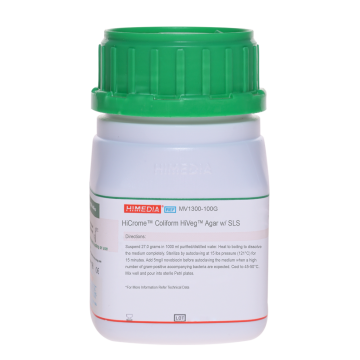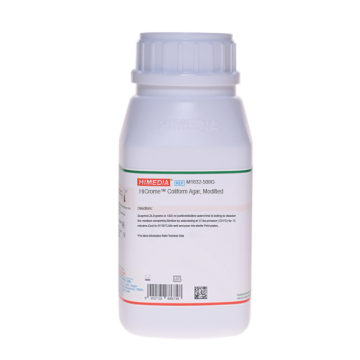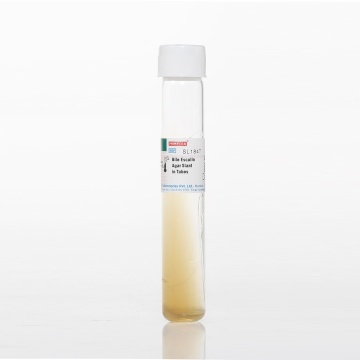 Your enquiry has been submitted
Your enquiry has been submitted
HiCrome™ Coliform Agar w/ SLS
Intended use
Recommended for the simultaneous detection of Escherichia coli and total coliforms in water, food and clinical samples.
Composition
| Ingredients | g/L |
|---|---|
| Peptone, special | 3.000 |
| Sodium chloride | 5.000 |
| Dipotassium hydrogen phosphate | 3.000 |
| Potassium dihydrogen phosphate | 1.700 |
| Sodium pyruvate | 1.000 |
| L-Tryptophan | 1.000 |
| Sodium lauryl sulphate | 0.100 |
| Chromogenic mixture | 0.200 |
| Agar | 12.000 |
Final pH (at 25°C): 6.8±0.2
**Formula adjusted, standardized to suit performance parameters
Directions
Suspend 27.0 gram in 1000 ml purified/distilled water. Heat to boiling to dissolve the medium completely. Sterilize by autoclaving at 15 lbs pressure (121°C) for 15 minutes. Cool to 45-50°C. Add 5mg/l novobiocin before autoclaving the medium, when a high number of gram positive accompanying bacteria are expected. Mix well and pour into sterile Petri plates.
Principle And Interpretation
HiCrome™ Coliform Agar w/ SLS is a selective medium recommended for the simultaneous detection of Escherichia coli and total coliforms in water and food samples (1). Peptone special and sodium pyruvate provide essential growth nutrients to the organisms. The phosphates buffer the medium well. The medium composition helps even the sub lethally injured coliforms to grow rapidly. Sodium lauryl sulphate inhibits gram-positive organisms. The chromogenic mixture contains two chromogenic substrates. The enzyme ß-galactosidase produced by coliforms cleaves one chromogen, resulting in the salmon red colouration of coliform colonies. The enzyme ß-glucuronidase produced by E. coli, cleaves X-glucuronide. E.coli forms dark blue to violet coloured colonies due to cleavage of both the chromogens (2,3,4). The addition of L-Tryptophan improves the indole reaction, thereby increasing detection reliability in combination with the two chromogens. To confirm E.coli, add a drop of Kovac's reagent (R008) on the dark-blue to violet colony. Formation of cherry-red colour indicates positive reaction.
Type of specimen
Clinical samples - faeces, urine, etc.; Food samples; Water samples.
Specimen Collection and Handling:
For clinical samples follow appropriate techniques for handling specimens as per established guidelines (5,6).
For food samples, follow appropriate techniques for sample collection and processing as per guidelines (7).
For water samples, follow appropriate techniques for sample collection, processing as per guidelines and local standards (8).
After use, contaminated materials must be sterilized by autoclaving before discarding.
Warning and Precautions
In Vitro diagnostic use. For professional use only. Read the label before opening the container. Wear protective gloves/protective clothing/eye protection/face protection. Follow good microbiological lab practices while handling specimens and culture. Standard precautions as per established guidelines should be followed while handling clinical specimens. Safety guidelines may be referred in individual safety data sheets.
Limitations :
- B-glucuronidase is present in 97% of E.coli strains, however few E.coli may be negative.
- Certain species of Shigella and Salmonella are ß-glucuronidase positive.
Performance and Evaluation
Performance of the medium is expected when used as per the direction on the label within the expiry period when stored at recommended temperature.
Quality Control
Appearance Light yellow to beige homogeneous free flowing powder
Gelling Firm, comparable with 1.2% Agar gel.
Colour and Clarity of prepared medium Light yellow, clear to slightly opalescent gel forms in Petri plates
Reaction Reaction of 2.7% w/v aqueous solution at 25°C. pH : 6.8±0.2
pH 6.60-7.00
Cultural Response Cultural characteristics observed after an incubation at 35-37°C for 24 hours (48 hours if necessary).
| Organism | Inoculum (CFU) | Growth | Recovery | Colour of Colony | Indole production |
|---|---|---|---|---|---|
| Citrobacter freundii ATCC 8090 | 50-100 | good-luxuriant | >=50% | salmon to red | negative reaction |
| Escherichia coli ATCC 25922 (00013*) | 50-100 | good-luxuriant | >=50% | dark blue/violet | positive, confirmation of red colour around the colony by addition of Kovacs reagent (R008) |
| Enterobacter cloacae ATCC 23355 (00082*) | 50-100 | good-luxuriant | >=50% | salmon to red | negative reaction |
| Enterococcus faecalis ATCC 29212 (00087*) | >=104 | inhibited | 0% | ||
| Klebsiella pneumoniae ATCC 13883 (00097*) | 50-100 | good-luxuriant | >=50% | light pink | negative reaction |
| Salmonella Enteritidis ATCQ3076 (00030*) | 50-100 | good | 40-50% | colourless | negative reaction |
| Shigella flexneri ATCC 12022 (00126*) | 50-100 | good | 40-50% | colourless | negative reaction |
Key: *Corresponding WDCM numbers.
Storage and Shelf Life
Store between 15-25°C in a tightly closed container and the prepared medium at 2-8°C. Use before expiry date on the label. On opening, product should be properly stored dry, after tightly capping the bottle in order to prevent lump formation due to the hygroscopic nature of the product. Improper storage of the product may lead to lump formation. Store in dry ventilated area protected from extremes of temperature and sources of ignition Seal the container tightly after use. Product performance is best if used within stated expiry period.
Disposal
User must ensure safe disposal by autoclaving and/or incineration of used or unusable preparations of this product. Follow established laboratory procedures in disposing of infectious materials and material that comes into contact with clinical sample must be decontaminated and disposed of in accordance with current laboratory techniques (5,6).
Reference
- Manafi M. and Kneifel W., 1989, Zentralbl. Hyg., 189:225.
- Frampton E. W., Restaino L. and Blaszko N., 1988, J. Food Prot., 51:402.
- Kilian M. and Bülow P., 1976, Acta. Pathol. Microbiol. Scand., Sect. B, 84:245.
- LeMinor L. and Hamida F., 1962, Ann. Inst. Pasteur (Paris), 102:267
- Isenberg, H.D. Clinical Microbiology Procedures Handbook 2nd Edition.
- Jorgensen, J.H., Pfaller, M.A., Carroll, K.C., Funke, G., Landry, M.L., Richter, S.S and Warnock., D.W. (2015) Manual of Clinical Microbiology, 11th Edition. Vol. 1.
- Salfinger Y., and Tortorello M.L., 2015, Compendium of Methods for the Microbiological Examination of Foods, 5th Ed., American Public Health Association, Washington, D.C.
- Lipps WC, Braun-Howland EB, Baxter TE, eds. Standard methods for the Examination of Water and Wastewater, 24th ed. Washington DC:APHA Press; 2023.C
| Product Name | HiCrome™ Coliform Agar w/ SLS |
|---|---|
| SKU | M1300 |
| Product Type | HiCrome™ |
| Physical Form | Powder |
| Origin | Animal |
| Packaging type | HDPE |
| References | 1. Isenberg, H.D. Clinical Microbiology Procedures Handbook 2nd Edition. |
| Customized Product Available | No |










